Discovering Pond Habitats: How To Do Nature Study in Real Life
Have you ever been to the same nature study destination so often that you almost forget there are always new things to discover?
My friend Tracy and her children had visited the same ponds many times over. They never really got tired of exploring, but she found a simple way to refocus their attention, which led to new observations and new learning.
Please welcome Tracy as she shares the most delightful post about her family’s quest to learn about pond habitats.
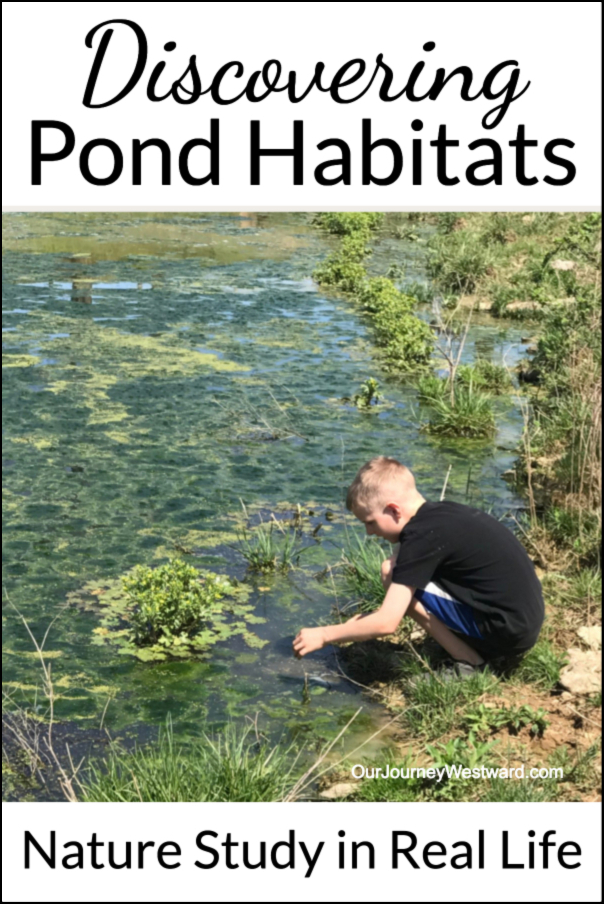
This post contains affiliate links.
Pond Habitat Nature Study In Real Life
Our love of nature study began at a pond. I had my children rambling around the pond as toddlers and preschoolers, my youngest just an infant and strapped into my baby carrier. We made some fond memories during those early explorations.
When we moved from the East Coast to the West Coast, some of our first great finds were the local ponds. Although the Pacific Northwest birds and plants differed vastly from what we were used to identifying, studying the ponds felt like home.
There is so much to see and explore in a pond nature study. We have studied the birds, identified the plants, and watched the turtles. We’ve searched for animal tracks, skipped rocks across the pond, and found crayfish in the shallows.
But it struck me recently that we’d never studied the ponds as a whole, as a habitat. It was time to zoom out and get a big picture of our favorite nature study spots. NaturExplorers’ Peaceful Ponds gave us just that opportunity.
Planning a Pond Nature Study
I’m pretty laid-back when it comes to my nature study preparation. Typically, I make it a habit to leave a margin in our schedule for spontaneous nature walks when the weather permits. I like to keep nature study books on hand and casually complete notebooking activities and art projects on rainy days. (We have a lot of those in the Pacific Northwest.)
As I prepared for our pond habitat nature study, I sat down with my iPad and planner to review all the amazing ideas in Peaceful Ponds. I took a few notes in my planner about what I wanted to cover, requested the recommended library books (and a few extras), and printed off the notebooking pages I wanted to use.

Observing Ponds Through the Seasons
The first objective was to study our ponds throughout each season, observing how our favorite nature study locations had changed. We watched as the winter rains began to fill these areas and scoured the mud for fresh tracks to see what creatures had come to visit (This idea came from another favorite study, NaturExplorers’ Animal Signs.)
Then, we patiently waited for signs of spring on the trees and bushes. Over the weeks, we welcomed the Canada geese back to the ponds where they nest, and we hopefully searched for the first tadpoles.
It was especially meaningful for my youngest to observe all the small changes taking place. However, my older two were also more in tune this year, as they watched water levels rise in the ponds and wetlands surrounding our house.

Pond Study in Bad Weather
Our nature walks were more like nature jaunts during wet and gloomy days. We made quick stops on our way home from an errand, sloshing through the mud for a quick peek at what was changing. Then we’d hurry home, brew cups of tea, and read books about ponds or complete nature journaling pages from our observations.
I especially loved all the Peaceful Ponds resources on these gloomy days. We could enjoy nature study from rich, living books and compare these books with our own observations from previous nature walks. We could study nature from the kitchen table or the living room floor in front of the fireplace! And, of course, all this indoor nature study made us long to get back out of doors to revisit our ponds and to see how they’d changed since our last visits.
Favorite Picture Books About Ponds

These books about ponds are our favorites, and most of them are included in the lengthy booklist that Cindy includes in the Peaceful Ponds curriculum guide!
Comparing Ponds During Nature Study
As the weather improved, I challenged my children with an assignment to compare and contrast our favorite ponds. Each one is a very different habitat!
This exercise was primarily oral for my younger two. Still, I did assign my eleven-year-old a nature notebooking activity from Peaceful Ponds and had him write two descriptive paragraphs about the differences.
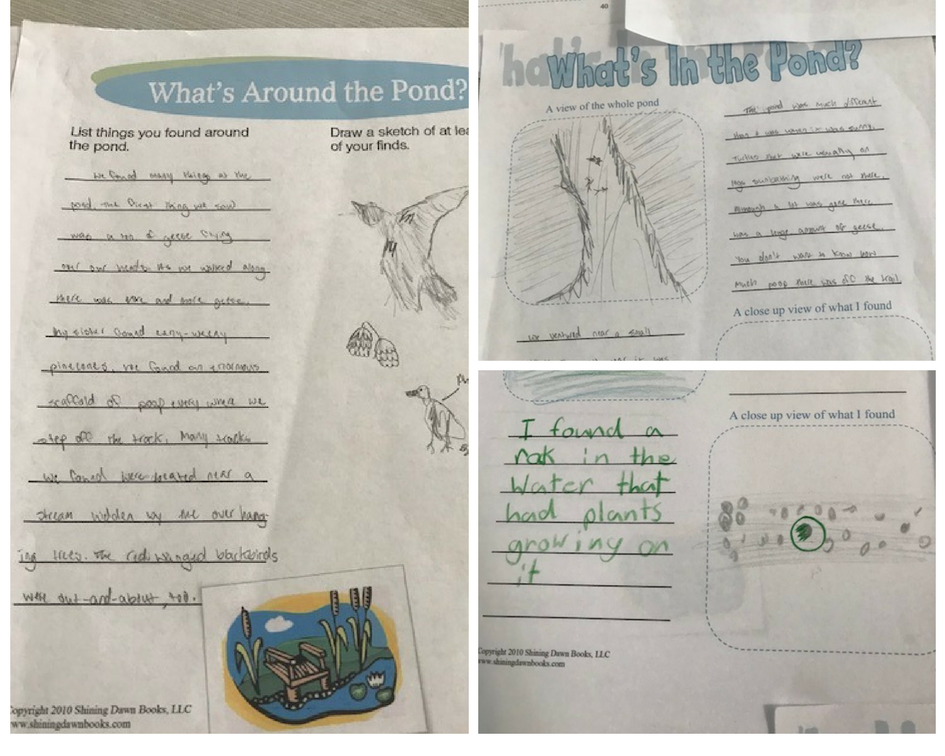
Nature Study Experiences at the Pond
One of the local ponds, which we refer to as the meadow pond, is situated in a field. Canada geese nest here, and mallards, coots, bushtits, and red-winged blackbirds are also regulars. Turtles love to sun themselves on a particular log in the middle of the pond. We sometimes spot turtle nesting holes or find cougar tracks in the mud. It’s one of our favorite spots because it is always teeming with animal life.
On one of our visits to the meadow pond, my youngest crouched down and slowly inched toward the shore to get a closer look at the turtles. “They think I’m a rock,” he whispered back to me loudly. After investigating as much as he wanted, he stood up, and the turtles instantly jumped off the log into the water. Their heads bobbed above the surface, eagerly awaiting the first opportunity to climb back onto their sunny log safely.
Before the turtles got comfy again, we completed one of the suggested activities from Peaceful Ponds. My kids waded out carefully to measure how high the water had come up on the “walking sticks” they had found along the way. (I knew this pond area wasn’t deep at all, so I allowed them to wade in. Typically, we would only measure from the safety of the bank.)
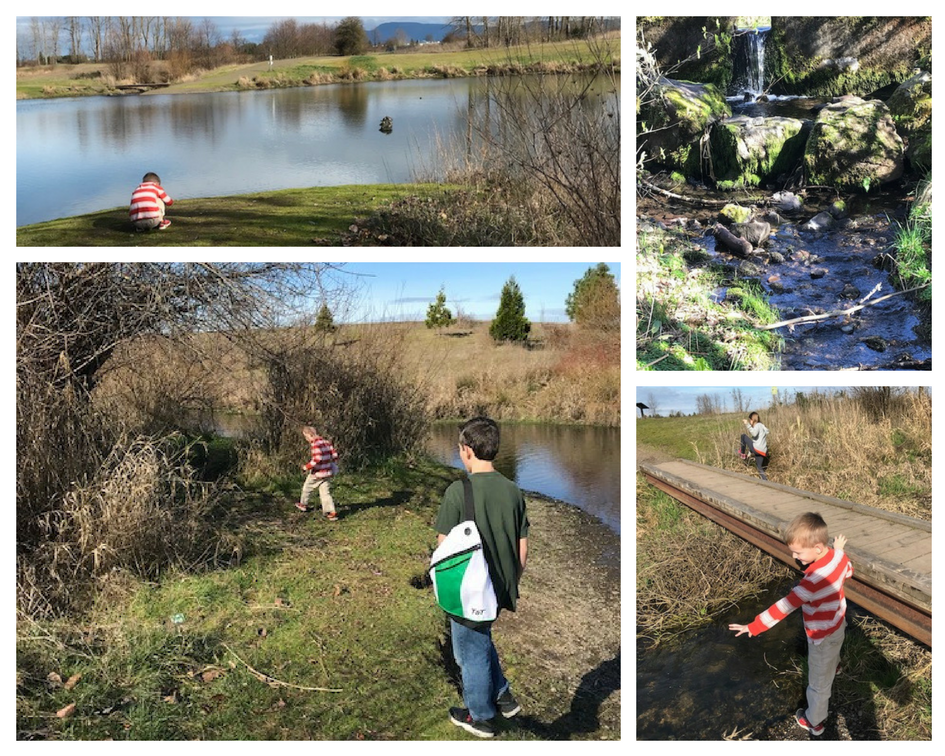
Comparing Streams and Ponds on a Nature Walk
On another nature excursion, we visited a very different location, featuring several ponds, a river, and various streams. As we hiked, we contrasted each of these. I asked them the differences between the river and the stream, and between the stream and the pond.
We observed a section of the stream that had been dammed, and my kids waited patiently for quite a while, hoping to spot a beaver. In the end, we only saw a garter snake slithering out of the water and into the grassy shore, which was pretty great, too.
When Pond Nature Study Requires Patience
The second pond site in this area is what we refer to as our lily pad pond. Tucked into the woods, this pond is very still (unlike the busy meadow pond) and appears to be empty. It requires patience.
My kids clustered at the edges of the bridge and peered into the water, eventually spotting tiny tadpoles. They also found a lone turtle on a lily pad across the pond, as well as tiny fish and bug larvae hiding in the shadows. My son also spotted a second garter snake sliding across a mossy log. As we hiked back, we saw several Stellar’s Jays, tree swallows, and some hawks circling overhead.
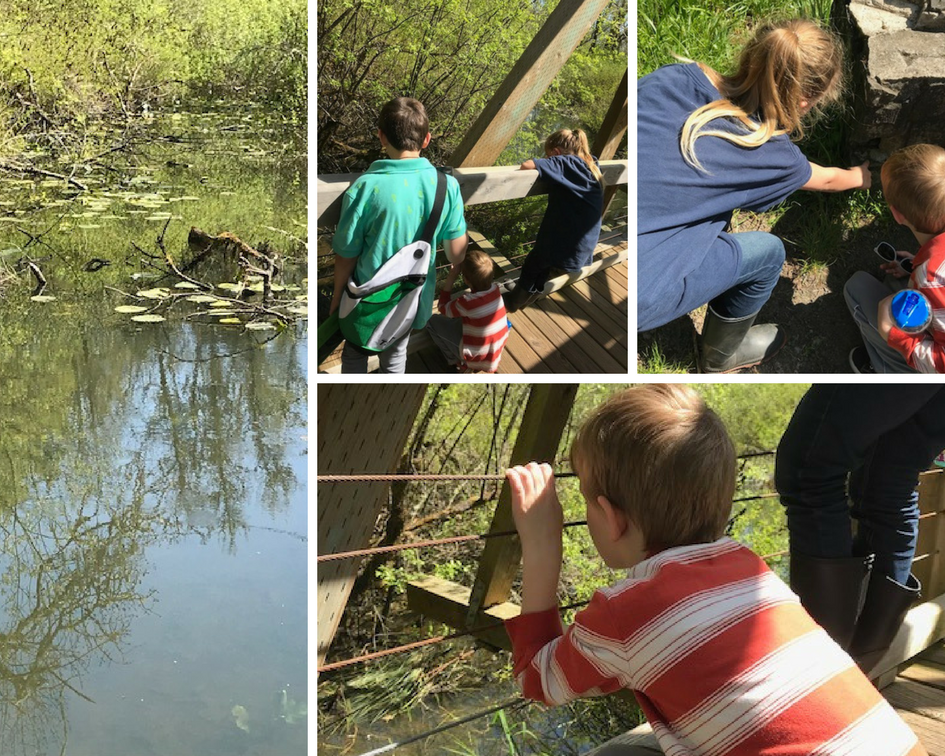
My eleven-year-old was thrilled with the rich material for his compare-and-contrast paper and eagerly took his own pictures throughout our hike.
The turtle was quite a find for this area. Bullfrogs had been introduced many years prior, and since they were not native to the area, they lacked natural predators. They disrupted the ecosystem and ate many of the baby turtles. We rarely spot anything but giant frogs in this pond. My kids were excited to add turtle-spotting to their nature journals!
Pond Art and Nature Study
Another feature I love about NaturExplorers is how it seamlessly integrates art, music, Bible study, and numerous other elements into the study of nature.
One of the suggested artists in Peaceful Ponds is Claude Monet. After visiting our lily pad pond, we reviewed what we knew about Monet and then attempted our own Monet-inspired painting of the lily pad pond. The kids were allowed to choose oil pastels, chalk pastels, or watercolors. Together, we drew and painted what we remembered from our nature walk.
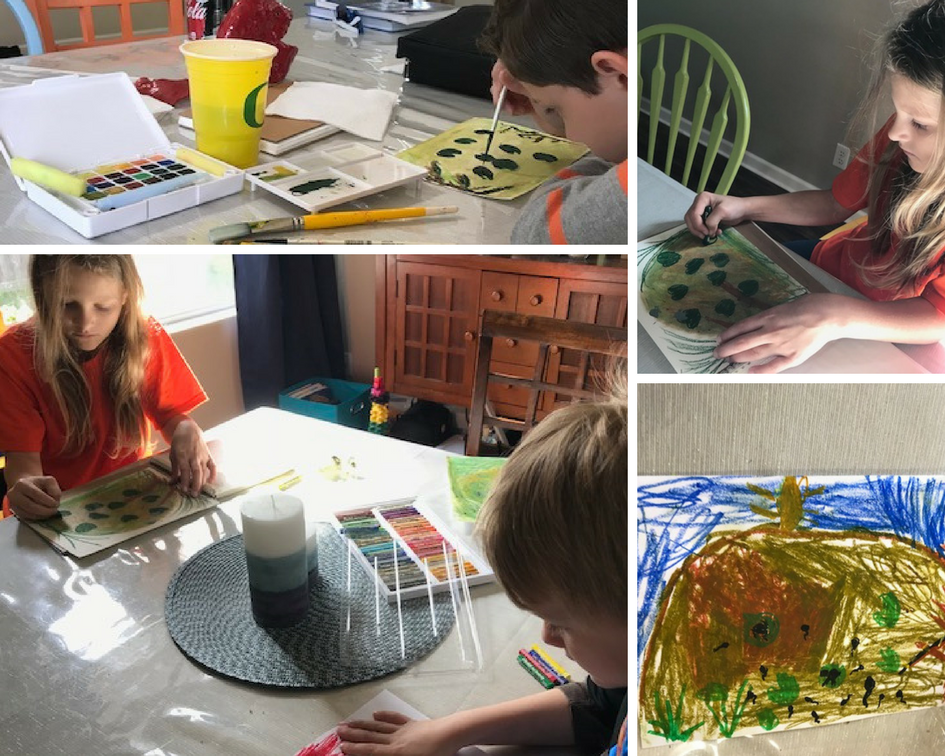
More Pond Habitats Nature Study
As pretty weather is finally here to stay for the season, we are hardly finished with our pond habitats nature study. Another activity from Peaceful Ponds that I’ve jotted down in my homeschool planner includes a microscope activity. Studying pond life under a microscope—complete with nature notebooking pages and web links for identification—will be a big hit with my children.
Over the years, we’ve completed several NaturExplorer guides; each one we finish becomes my new favorite. I love that the guides provide us with a jumping-off point, enticing us further into our studies. I love how the guides equip me to ask thought-provoking questions that encourage my kids to think about nature in a new way. The variety ensures that something from our study will resonate with my diverse group of kids, regardless of their age or personality.
Nature Study Isn’t for Experts
Studying nature is not just for the experts, but also for outdoorsy people. Trust me, I’m neither an expert nor an outdoorsy type. However, nature study is one of the best parts of our homeschool, providing connection, relationship, exploration, and many fond memories. I love how nature study is a “living science lab,” teaming with opportunities and memories that will guarantee we’ll study nature for a long time.
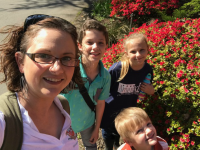
Hi! I’m Tracy, and I homeschool my crew of three kids with ADHD/dyslexia. I find creative ways to use their strengths to teach their weaknesses. Our life is creative chaos, and our homeschool is loud, busy, distracted, challenging, and lovely. In addition to writing and editing curriculum, I blog at Growing In Grace, providing grace and knowledge.
Supporting Classes in the No Sweat Nature Study Membership
Other Posts You Might Like





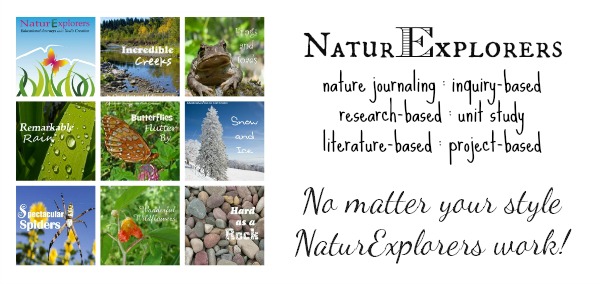
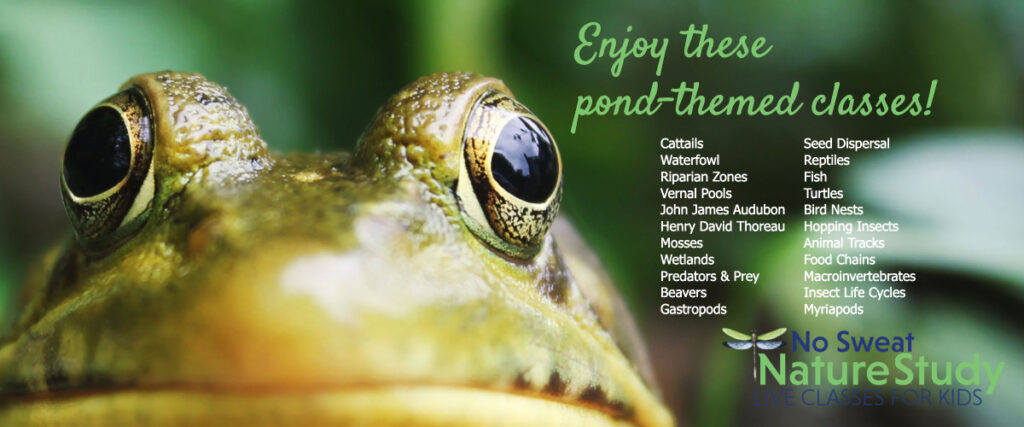
2 Comments